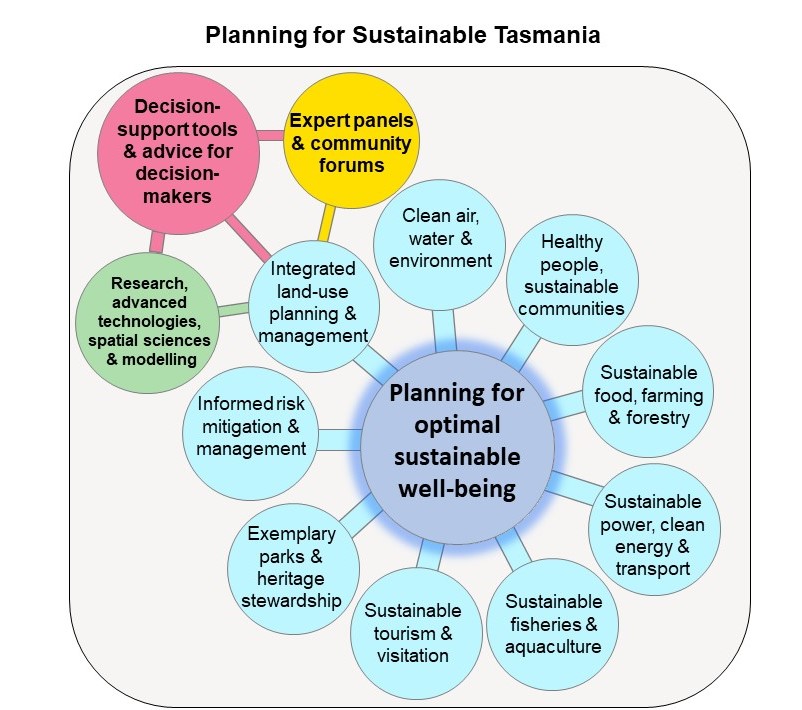Tasmanian State Government Planning Reforms and related documents
The current Tasmanian State Government is changing the Planning system in ways that are causing multiple and widespread community concerns.
For information provided by the Government about these Planning law reforms, go to http://planningreform.tas.gov.au.
- For the Tasmanian State Planning Provisions (SPPs) Tasmanian Planning Scheme click here.
- For the government's Explanatory Document on the Draft SPPs click here.
Representations: Over 300 representations (submissions) from the public covering more than 3,000 issues were made in relation to the new draft State Planning Provisions. These representations are available on the government's iplan website at www.iplan.tas.gov.au under reviews and hearings, and search on SPP. Or for user-friendly access, click here and scroll down to documents.
Submissions of particular interest include those from:
- Local Councils, many of whom share numerous and significant concerns about the proposed State Planning Provisions. For example, Hobart City Council sought over 300 changes to the Draft SPPs; Kingborough Council identified numerous issues; and Launceston submitted a representation covering 89 issues in their submission to the Tasmanian Planning Commission.
- University of Tasmania, Geography & Spatial Science submission - click here for the full submission.
- Community interest groups such as the Friends of the East Coast submission - click here; and North East Bioregional Network Submission - click here.
- Numerous concerned members of the public - for an example submission, click here.
For additional information and community viewpoints see Why These Planning Changes Matter.
A better way forward: TasPIN believes there is a better way forward through sound strategic planning to create Tasmania's optimal sustainable future in meaningful consultation with the Tasmanian community.
Planning for Tasmania's future
Planning for Tasmania's optimal sustainable future
TasPIN believes collaborative leadership and a best practice Tasmanian Planning system are needed to envisage and deliver the best possible sustainable future for our collective community and planetary well-being.
Sound strategic Policy and Planning, developed in respectful consultation with the Tasmanian community and stakeholders, are vital for Tasmania to flourish sustainably now and in future. Below is a concept of what a collaborative approach to Planning for Sustainable Tasmania might look like.

Source: modified after Jones and Sainsbury 2020; Jones 2021
The UN Sustainable Development Goals
The United Nations has provided a global blueprint for achieving a better and more sustainable future for all. The UN Sustainable Development Goals (SDGs) provide a widely accepted framework that can be used to help inform and guide sound strategic planning for desired outcomes at all levels. The SDGs have been officially adopted by 193 countries. See the 17 global goals here: UN Sustainable Development Goals.
Tasmanian community aspirations
The following initiatives have set out to work with community aspirations to inform and shape strategic planning for Tasmania's future. The findings from these initiatives provide important resources for planners, politicians, governments, policy- and decision-makers, and all Tasmanians with an interest in helping to shape Tasmania's future.
The Tasmania Together initiative
Tasmanian Together was a Tasmanian State Government initiative which aimed to develop and implement a community-envisaged, outcomes-focused plan to guide the social, environmental and economic future of Tasmania. The initiative commenced in 1999 and ran for over a decade but was effectively abandoned in 2012 following a change in Government. Valuable lessons can be learnt from considering the goals that were identified, the governance and resourcing arrangements that were applied, reflecting on what worked and what didn't, and the factors that may have contributed to successes and ultimate failure.
The Tasmania Together plan
Key documents from the Tasmania Together initiative included (in reverse chronological order):
- Tasmania Together Vision and Goals (2011)
- Tasmania Together [the plan, revised 2011]
- Tasmania Together 2020 [the plan, revised 2006]
- Guide to understanding Tasmania Together benchmarks (2007)
- Tasmanian Together Progress Report 2004
Tasmania Together background and history
In May 1999, Tasmania’s then Labor Premier Jim Bacon appointed 22 community members from diverse backgrounds to develop a government-funded plan for the state’s future by 2020. Additional individuals were subsequently invited to contribute to development of a draft Tasmania Together plan which was circulated to 14,000 community members for feedback. Following further meetings and consultations, a final first plan was published in October 2000. The Tasmania Together initiative was widely regarded as world-leading in terms of community engagement, strategic planning and performance reporting.
The plan included 24 primary goals and 212 benchmarks, and was promoted as providing ‘Tasmania’s pathway to the future’. Legislation was passed in 2001 to establish a statutory board to monitor, promote and report on the 20-year Tasmania Together plan for Tasmania. The Act also required that the plan be reviewed and revised every 5 years in consultation with citizens to ensure it remained relevant and appropriate.
The project, with its broad range of goals and benchmarks in pursuit of a better life for Tasmanians, won praise from some circles for its consultative approach and its effect on policymaking. However, there were also ongoing accusations of interference and a watering down of the original Tasmania Together community aspirations by vested interest groups — including from forestry and gambling. (Source: https://www.abc.net.au/news/2020-01-11/tasmania-together-jim-bacon-1999-vision-a-decade-on/11812944)
In June 2011, following a change in government, responsibility for Tasmania Together benchmarks was transferred to government agencies, with the Tasmania Together Secretariat being integrated into the Department of Premier and Cabinet. In 2012, the Tasmania Together Progress Board Act 2001 was repealed and the Tasmania Together Progress Board was disbanded. Resourcing for the Board, which was allegedly in the order of $1million per year, was absorbed into government agencies to support the new Tasmanian government's priorities, which included data collection, performance reporting, community consultation and community engagement. (Source: Tasmanian Parliament Fact Sheet)
The abolition of the Tasmania Together Progress Board was met with significant public controversy and concern for the future of Tasmania Together. The chairman of the Tasmania Together board suggested there would no longer be a 'spin-free-story' about the plan’s progress and that Tasmania Together would be heavily influenced by political agendas.(Source: https://participedia.net/organization/717).
Tasmania Together today
Today there is little evidence of the Tasmania Together initiative on government websites, with only the following resources able to be located:
- Department of Premier and Cabinet (DPAC): Tasmania Together - the first 5 year review; and Contribution to Tasmania Together benchmarks (apparently last updated in 2011).
- Australian Bureau of Statistics (archived issue): 1384.6 - Statistics - Tasmania, 2002
Reflections on the Tasmania Together experience
In 2020, marking the envisaged full term of the Tasmania Together 2020 plan, members of the original Community Leaders Group shared their views on the Tasmania Together initiative with journalist James Dunlevie (ABC News 11 January 2020):
- Julie Macken (journalist) said she remembered that in 1999 the state was at a crossroads. "[The question for Tasmanians was] are we going to become this incredibly cool and clever state, where we produce amazing food, a beautiful place with an exciting culture...or [are] we going to be logged out, clapped out, where the lowest common denominator rules in terms of business?"
- Communities and individuals "create our futures, either by thinking about them, or not thinking about them" (Julie Macken)
- "Tassie is in a pretty good place today, compared to 1999" (Judy Tierney, retired journalist)
- Gerard Castles (strategic communications specialist) said the project was worthwhile although there were still huge challenges. He said:
- "What was lacking in the late 90s [was] any clear vision of where we wanted to go; once that stake was in the ground … it began a radical re-engineering of the way Tasmanian society worked, across education, government, health, bureaucracy [and] that overall vision was the key engine that drove change...Talk to a 20-something now and it is 'really cool to live in Tasmania'. That was unimaginable [in 1999]."
- "The Tasmania Together project, for all its flaws and arguable outcomes, was vitally important for the state — mostly because of what it offered Tasmanians. It asked Tasmanians to dream of a future they wanted to have; once they articulated that, it helped the state change forever."
(Source: https://www.abc.net.au/news/2020-01-11/tasmania-together-jim-bacon-1999-vision-a-decade-on/11812944)
The Tasmanian Way
What is The Tasmanian Way?
The Tasmanian Way (www.tasmanianway.org) is a community-developed platform created to inspire a whole-of-Tasmania approach to reduce emissions, build resilience and transition to a sustainable way of doing things for the health, well being and prosperity of all Tasmanians. It is a commitment by change makers to ambitious and measured goals and targets to make Tasmania a global sustainability leader.
Background
The Tasmanian Way initiative emerged from a group of Tasmanians coming together with the same question: 'Can we work together to shape our future?' The answer to the question was a resounding ‘yes’.
The first Tasmanian Way Forum was held in September 2019 to initiate the process to co-create a state-wide plan to shape Tasmania's food and waste systems for a circular economy in Tasmania and to position Tasmania as a global leader in the implementation of the United Nations 2030 Sustainable Development Goals (SDGs).
Tasmanian Way is auspiced by Tasmanian Leaders Inc. and coordinated by Jessica Robbins, Founder and Director.
Thriving Tasmania - online event and outputs
During the COVID-19 isolation in 2020, a free online event was convened, aimed at all Tasmanians, titled: 'Thriving Tasmania: emerging stronger' .
Thriving Tasmania outputs include:
- SUMMARY document which pulls together the ideas, dreams and wishes of participants about what they see as important to emerge and shape a thriving Tasmania.
- VIDEO providing a snapshot of the Thriving Tasmania conversation.
Addressing global risks to humankind and our collective well-being
The Australian National University (ANU) Commission for the Human Future (Chairman: John Hewson) has released a report identifying 10 global catastrophic risks and calling on all Nations and peoples to come together, as a matter of urgency, to prepare a plan for humanity to survive and thrive. The report - Surviving and Thriving in the 21st Century - identifies the following ten potential catastrophic risks.
The ten risks* are:
- Decline of key natural resources and an emerging global resource crisis, especially in water
- Collapse of ecosystems that support life, and the mass extinction of species
- Human population growth and demand, beyond the Earth’s carrying capacity
- Global warming, sea level rise and changes in the Earth’s climate affecting all human activity
- Universal pollution of the Earth system and all life by chemicals
- Rising food insecurity and failing nutritional quality
- Nuclear arms and other weapons of mass destruction
- Pandemics of new and untreatable disease
- Advent of powerful, uncontrolled new technologies
- National and global failure to understand and act preventively on these risks.
*Note: A catastrophic risk is one that menaces human civilization in general. An existential risk is one that may potentially extinguish the human species.

"The short-termism of our political process needs to be circumvented. We must consider how our actions today will resonate for generations to come" (Hunter and Hewson, 2020).
Image: Danielle MacInnes (Unsplash web)
Practical steps on Tasmania's path to a more sustainable future
- Flick the Switch is a guide to achieving Net Zero and all-electric buildings and cities. Read or download the Flick the Switch Ebook (produced by The Fifth Estate).
- The Tasmanian Department of State Growth has released a draft Renewable Energy Action Plan which commits to 200% renewable energy.
